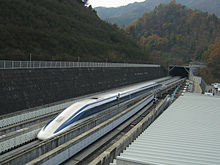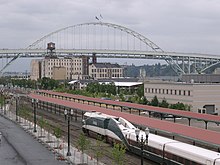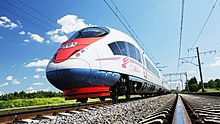High-speed rail





High-speed rail (HSR) is a type of rail transport that operates significantly faster than traditional rail traffic, using an integrated system of specialized rolling stock and dedicated tracks. While there is no single standard that applies worldwide, new lines in excess of 250 kilometres per hour (160 mph) and existing lines in excess of 200 kilometres per hour (120 mph) are widely considered to be high-speed. High-speed trains normally operate on standard gauge tracks of continuously welded rail on grade-separated right-of-way that incorporates a large turning radius in its design. Many countries have developed high-speed rail to connect major cities, including Austria, Belgium, China, Finland, France, Germany, Ireland, Italy, Japan, Morocco, the Netherlands, Poland, Portugal, Russia, Saudi Arabia, South Korea, Spain, Sweden, Turkey, the United Kingdom, and Uzbekistan. China had 29,000 kilometres (18,000 mi) of HSR as of December 2018, accounting for two-thirds of the world's total. Speed had always been an important factor for railroads and they constantly tried to achieve higher speeds and decrease journey times. In general, travel by high-speed rail has been demonstrated to be remarkably safe.
Quotes
[edit](Sorted alphabetically by author/source)
- Up to six million people travel on China’s expanding high-speed rail network on any given day...The sprawling legions of 5G cellular base stations and towers that China Mobile spent years constructing along trunk rail routes can now be readily tapped to transmit huge chunks of data.This will enable for the first time simultaneous ultra-high definition video streaming and conferencing between a driving cab and a control center for better monitoring and trouble-shooting, even when a bullet train is galloping along at 350 kilometers per hour. That is on the strength of the proof-of-concept beam-forming technology as well as millimeter wave spectrum as key enablers to offer reliable service to drivers and passengers alike, including as the backhaul for train marshaling and on-board Wi-Fi.
- Asia Times: 5G to speed up data from bullet trains in China (22 March 2019)
- Ever since ASCE (the American Society of Civil Engineers) began issuing its “National Infrastructure Report Card” in 1998, the nation has gotten a dismal grade of D or D+. In the meantime, the estimated cost of fixing its infrastructure has gone up from $1.3 trillion to $4.6 trillion.
While American politicians debate endlessly... the Chinese have managed to fund massive infrastructure projects all across their country, including 12,000 miles of high-speed rail built just in the last decade...
A key difference between China and the US is that the Chinese government owns the majority of its banks... The US government could do that too, without raising taxes, slashing services, cutting pensions, or privatizing industries...
- (The United States is) the most warlike nation in the history of the world... How many miles of high-speed railroad do we have in this country?... We have wasted, I think, $3 trillion (military spending) ... China has not wasted a single penny on war, and that's why they're ahead of us. In almost every way... And I think the difference is if you take $3 trillion and put it in American infrastructure, you'd probably have $2 trillion left over. We'd have high-speed railroad. We'd have bridges that aren't collapsing...
- Jimmy Carter quoted in President Trump Called Former President Jimmy Carter To Talk About China, Emma Hurt, NPR (April 15, 2019)
- In Europe and Asia, there are numerous high-speed rail (HSR) lines. For 2015, the U.S. High Speed Rail Association reported that there were 29,792km (18,512 miles) of high-speed lines, 3,603 train sets in operation and 1.6 billion passengers traveling on those lines annually. China alone laid about 19,000km (roughly 12,000 miles) of HSR in just nine years. Compared to other industrialized countries, the U.S. is woefully behind.
Why is the U.S., which is usually so proud of its technological acumen, so slow on the railway tracks? Though electric streetcars were prevalent throughout the U.S. in the earlier part of the 20th century, most cities saw this energy-efficient form of transportation disappear for various reasons, including a possible conspiracy by Firestone Tire, Standard Oil of California, Phillips Petroleum, Mack Trucks and General Motors to monopolize and dismantle the streetcar system. At the same time, auto interests fought pedestrians to reframe streets as designated for vehicles. GM also played a key role...
[Presently,] the billionaire Koch brothers and their network of think tanks and dark money groups have been funding efforts to stop HSR and other public transit projects from taking place.- Engineering.com The Rest of the World Has High-Speed Rail, Why Can’t the U.S.? Engineering.com,Michael Molitch-Hou (22 March 2019)
- The Green New Deal’s focus on investing in high-speed rail could mean significant potential work for electricians and rail workers...
- Former president Jimmy Carter recently made a profound and damning statement — the United States is the “most warlike nation in the history of the world.” Carter contrasted the United States with China, saying that China is building high-speed trains for its people while the United States is putting all of its resources into mass destruction. Where are high-speed trains in the United States, Carter appropriately wondered... As if to prove Carter’s assertion, Vice President Mike Pence told the most recent graduating class at West Point that it “is a virtual certainty that you will fight on a battlefield for America at some point in your life... You will lead soldiers in combat. It will happen.” Clearly referring to Venezuela, Pence continued, “Some of you may even be called upon to serve in this hemisphere.” In other words, Pence declared, war is inevitable, a certainty for this country.
- We must stop our nation’s push for relentless war By Oliver Stone and Daniel Kovalik, Boston Globe, (July 1, 2019)
- It is a fight to the death between Big Oil and everybody else. Everybody else will benefit from HSR. It cleans up the air. It opens up all kind of new possibilities where you can live a more affordable life and get jobs further away... Everyone is going to benefit, except the oil industry, and that’s where the problem is.... There are some major changes needed to our transportation sector, which means that we need to electrify it. That will mean a whole lot of work for engineers... This is a huge project that the engineering profession needs to step up and be the leaders on.
It’s not just an opportunity that means lots of jobs. It means the engineering profession gets to be front and center when solving this humongous problem that everyone looks at as almost unsolvable. It’s not unsolvable. It’s very solvable..- Andy Kunz, president of the U.S. High Speed Rail Association (USHSRA) quoted in: The Rest of the World Has High-Speed Rail, Why Can’t the U.S.?Engineering.com, Michael Molitch-Hou (22 March 2019)
- In 2008, voters approved a $10 billion bond to begin construction of a bullet train from Los Angeles to San Francisco that would make that trip in less than three hours. So who knew that by 2011 the general consensus would be that the project is an ill-conceived, mismanaged boondoggle? Former Amtrak spokesman and Reason Foundation writer Joseph Vranich knew. In 2008, before the state Senate Transportation and Housing Committee, he called the project "science fiction." He said the train won't travel from Los Angeles to San Francisco in less than three hours because that exceeds the speed of all existing high-speed rail. But on French railway schedules, a TGV (Train À Grande Vitesse) takes two hours, 38 minutes to go from Paris to Avignon... 430 miles... L.A.-to-San Francisco...is 432.
So what's going on here? It's simple. Vranich makes stuff up ... The Reason Foundation says the Europeans are abandoning rail in favor of driving and flying. Nonsense. Transportation market share of European high-speed rail lines has grown steadily and many are near 80 percent.
- SF Gate: The great high-speed rail lie, SF Gate, Roger Christensen (3 August 2011)
- The Reason Foundation is funded by Chevron, ExxonMobil, Shell Oil, the American Petroleum Institute, Delta Airlines, the National Air Transportation Association and, of course, the Koch Family Foundation. They know what will happen once Americans, furious about gas prices and the way airlines treat them, experience electrically powered 200-mph trains. But big oil and aviation can't attack high-speed rail directly - that would be an obvious attempt to abort competition. So they hire a "think tank". Where does the corporate cash and propaganda end and the legitimate criticism begin? It was impossible to know in Florida, where high-speed rail was killed using the same techniques.
- SF Gate: The great high-speed rail lie, SF Gate, Roger Christensen (3 August 2011)
- China plans to expand its high-speed rail network by 3,200km in 2019, which is more than is currently being operated in either Spain, Japan, Germany or France, in a bid to aid a slowing economy locked in the trade war with the United States.
- While travelers in places like Europe and Japan enjoy high-speed rail travel, Americans are forced into a continued dependence on fossil fuel. Amtrak trips are either exorbitantly priced or entirely illogical... Even when travelers catch a bit of luck and get a discount price and a direct route, there is no guarantee of service since Amtrak has to share tracks with freight cars. Since commerce is king in American capitalism, Amtrak departure and arrival times are more like a best guess than a schedule.
The solution... is exceedingly simple. Make a serious national commitment to create high-speed rail service. Not a public-private joint venture or an outsourced pastiche of private lines, but a national public rail service. If given the choice between the green efficient trains and pollution belching buses, I am sure millions of Americans would hit the rails.- Billy Wharton:Badgers, Buses and Trains', CounterPunch, (26 August 2010)
 |
 |
 |
 |

